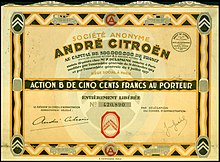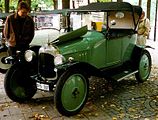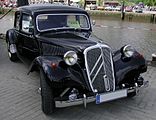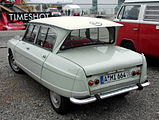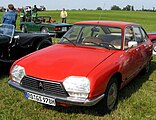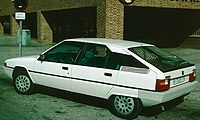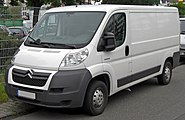Citroën
| Citroën SA
|
|
|---|---|
| legal form | Société Anonyme |
| founding | 1919 |
| Seat | Rueil-Malmaison , France |
| management | Vincent Cobée (since January 2020) |
| Branch | Automobiles |
| Website | www.citroen.com |

Citroën [ sitʀoˈɛn ] is a French automobile manufacturer and brand . The Citroën SA is a subsidiary of Peugeot SA , as Groupe PSA (PSA) occurs in the market. The DS Automobiles brand ( DS for short ), founded in 2014, functions as a premium sub-brand of Citroën SA
In 2014, Citroën (including DS) sold 1,303,706 vehicles worldwide.
Citroën won eight manufacturers' titles in the World Rally Championship from 2003 to 2012. The Citroën driver Sébastien Loeb won nine drivers' titles in a row from 2004 to 2012. This makes Citroën the manufacturer with the most drivers 'titles and the second most manufacturers' titles in the history of the World Rally Championship.
history

Foundation and first ranges
Citroën was founded by André Citroën (1878–1935). The origin of the company emblem is the double helical toothing (herringbone toothing) of gears , the company's first production focus. André Citroën acquired a patent for a manufacturing process for a gear cutting machine on a trip through Poland in 1900 to produce herringbone gears for gears according to an arrangement invented by Joseph Woollams in 1820 (English patent no. 4477 of June 20, 1820).
From 1915 onwards, production was converted and around 23 million shrapnel shells were made for the First World War . This provided the necessary start-up capital to roll off the first large-scale European automobile , the Citroën Type A , after the end of the war in 1919 . The electric starter and the spare wheel on this vehicle were special at the time.
Company developments
- In 1919 production of the first Citroën Type A 10 hp began. At that time assembly line production was introduced in Europe. The Citroën Type A already had electric lights and an electric starter as standard.
- In 1920, Citroën introduced replacement parts to 300 authorized dealers in France.
- In 1921, Citroën was the first provider of leasing and rental cars.
- In 1921, Citroën put up a total of 165,000 street signs and signposts across France with the subtitle “Don de Citroën” , “Donated by Citroën” .
- In 1922, Citroën proved the reliability of the converted Citroën half-track vehicles of the type B2 10HP (Kégresse) by crossing the Sahara via the route from Touggourt and Timbuktu . This expedition was followed by the famous Croisière Noire in 1924 and the Croisière Jaune in 1931 (see below).
- In 1923, Citroën introduced fixed repair prices and Citroën model cars as well as electric or pedal- powered children's cars (Citroënette) . Even Citroën scooters (Trotinette) for children of less wealthy families were produced.
- In 1924–1925, eight vehicles crossed Africa from Colomb-Béchar to Antananarivo during the Croisière Noire expedition .
- In 1926, Citroën issued Europe's first ten-year bonds .
- In 1927, Citroën was the first company in Europe to introduce the 13th month salary.
- In 1928 Citroën founded a vocational school.
- In 1929, Citroën gave a one-year warranty on new cars.
- In 1931 the reliability test and world tour of Croisière Jaune from Paris to Beijing took place. 35 vehicles set off on a 20,000 km promotional trip.
- In 1933 a Citroën 8 CV Petite Rosalie drove 136,000 km with an average of 104 km / h in 54 days in Montlhéry , setting a world record .
- The first front-wheel drive Traction Avant, built on a self-supporting all-steel body, left the factory in 1934. Because of its good road holding, the Traction Avant is said to have been popular with criminals, for example bank robbers, as an escape vehicle and was therefore also referred to as the “gangster limousine”. Its creators were the designer André Lefèbvre and the designer Flaminio Bertoni .
Citroën assembly plant Cologne-Poll
In the 1920s, the Citroën models also had great success in Germany, but this threatened to come to an end due to high tariffs to strengthen the German economy. Individual parts and forged parts were exempt from the so-called milk can tariff . An assembly plant was set up in Germany, which started production in 1927 (before Ford Cologne ) and now advertises Made in Germany . Because of hostility, they also switched to increasingly using German parts. By 1935, 18,710 vehicles had been delivered, as well as a total of 1,541 commercial vehicles such as omnibuses, flatbed trucks, articulated trucks, cattle trucks and half-track vehicles such as the Citroën-Kégresse P17 . When the Franco-German trade agreement was terminated by Germany in 1934 and the main plant in France ran into economic difficulties in 1935, production in Cologne was discontinued and only repairs were carried out until 1940, until the plant in 1940 for war production by the Klöckner-Humboldt-Deutz plants was expropriated. The most famous car was the Citroën Traction Avant Six, which was built here in 1934/35.
Other facilities in the Citroën era
Citroën opened a company kindergarten, founded and maintained a company orchestra, introduced health insurance and a pension for employees. Schoolchildren learned a lot about foreign cultures from the goods brought with them by the Croisières - the objects were passed through the country's schools as a traveling exhibition.
The global economic crisis , André Citroën's playing nature and the high development costs for the Traction Avant model brought Citroën into financial difficulties, and in 1934 it had to file for bankruptcy . As the largest creditor, the Michelin brothers took over the company. It is thanks to her foresight that the almost completely developed new model came onto the market.
André Citroën died on July 3, 1935 at the age of only 57. He did not live to see the success of the Traction Avant.
Second World War
Shortly before the Second World War , Citroën had a number of new models in the planning and testing phase:
- Front-wheel drive 8-cylinder prototypes ( sedan / convertible ) based on the Traction Avant , but with a 22-CV engine consisting of two 11-CV engines assembled in a V-shape under the extended hood . The prototypes were shipped to Mauritius or Madagascar at the beginning of the war and have been missing since then.
- Lightweight forward control -Lieferwagen, internal designation TUB
- Prototypes of the TPV , the Toute petite voiture , the “very small car”. Production began in 1936; after 250 copies it was discontinued because the factory was needed for tank production. Most of the cars were scrapped so that they would not fall into the hands of the Germans, but some were only well hidden - three of them (two limousines and a pick-up ) so well that they were only in 1995 in the attic of an old villa on the former Citroën proving ground at La Ferté-Vidame in France.
During the war, the development department worked to make energy sources such as alcohol, gas (wood gas and liquefied gas) or electricity usable for vehicle operation in order to compensate for the effects of gasoline rationing. Various Citroën vehicles, mainly commercial vehicles, were fitted with Brandt wood gas generators at the factory.
post war period

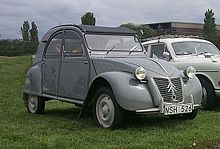
After the Second World War , the pre-war models were initially continued to be built.
In 1947, the from was TUB time refined and therefore long colloquially still TUB -called vans of the type H (later, HY, HX, HW HZ and 1600) presented a year later on July 8, 1948, the TPV advanced 2 CV , also known as "duck" because of its shape. Internally, the model was again as Type A , the van version as AU out, technically, there is no common ground with the pre-war type A . 1955 followed the model series D ( DS , "the goddess"), and replaced the Traction Avant , which was built until 1957 . In 1955, Citroën took over a 25 percent stake in the French company Panhard .
Flaminio Bertoni's design of the D-model range (known as DS ) was way ahead of the competition at the time. When asked whether this was the car of tomorrow, André Lefèbvre, head of development, replied : “No, this is today's car, all other cars are from yesterday.” But not only the design was modern, but also some of them Technology: With the DS, the hydropneumatic suspension was introduced on all wheels via the central hydraulics under high pressure . Further technical innovations of the DS were the hydraulic power steering and the hydraulic brake booster. In 1968, cornering lights were introduced on the high-beam headlights, as well as the automatic height adjustment of both pairs of headlights (low beam and high beam) depending on the situation.
The four-cylinder engine with first 1900 cc displacement and 55 kW (75 hp) was provided with only one new aluminum cross-flow cylinder head, taken from the 11 CV. From 1965 there was a newly designed engine series with a displacement of 2200 cm³ and 78 kW (104 hp). The DS always had four-cylinder engines. Although 6-cylinder boxer engines were planned and developed for the DS, these did not meet the decision-makers' expectations, which is why the predecessor's conventional in- line engine was used. In order for this to fit under the flat bonnet, it was pushed into the interior under the dashboard as far as possible, which made a hole in the windshield frame necessary in order to be able to access the fourth spark plug .
In 1965 Panhard was completely taken over. Although Citroën did not have a mid-range vehicle on offer, the Panhard 24 was only built for two years, after that only armored vehicles .
Ami , Dyane and Méhari appeared in the segment of small cars and the lower middle class , a middle class vehicle GS was presented in 1970. Citroën built trucks , bought Maserati - from which the upper-class sports coupé SM emerged - and built a GS version with a rotary engine . The oil crisis put an end to these expensive attempts and Citroën faced bankruptcy in 1974. The majority shareholder Michelin tried to sell parts to Fiat . The commercial vehicle division was sold to Renault , Maserati to de Tomaso .
The PSA era


In 1975, the previously competing Peugeot SA took over Citroën SA as its subsidiary. Since then, the partially listed Peugeot SA has operated as a holding company under the group brand PSA Peugeot Citroën ( PSA for short ), under which all models of the group brands are developed on common platforms.
The last Citroën model before the merger was the CX , the first joint models were the Visa and the LN , which shared the technical basis with the Peugeot 104 . The LN also had the body of the 104 Z , while the design of the Visa body was based on a Citroën design from pre-PSA times, which could not be realized due to the common platform.
The original Visa was later built in Romania by the Oltcit joint venture and exported to Western Europe as the Citroën Axel , although no component was the same on the two models, which were extremely similar in appearance. The engines of the two-door Oltcit from France were the air-cooled 4-cylinder boxer engines of the larger GS model . The Visa had the slightly enlarged and somewhat modified, air-cooled 2-cylinder boxer engine of the Citroën 2 CV with 652 cm³ (while the 2 CV had a maximum of 602 cm³ engines) or, as Visa II, water-cooled Peugeot engines. Analogous to this, there were the same engines in the LN , which - equipped with the water-cooled 4-cylinder in-line engines - was offered as the LNA.
In October 2005, Citroën announced that it was cooperating with the gas supplier GDF Gaz de France on the natural gas car market and that, from 2007, it would offer vehicles for self-refueling at domestic gas connections in the Toulouse area . The necessary 500 euro compressor will be provided free of charge.
At the end of 2013, rumors were circulating that Citroën wanted to give up hydropneumatic suspension, which even prompted Citroën fans to petition the manufacturer. At the Geneva International Motor Show 2014, the new C5 Crosstourer was presented as "currently the only hydropneumatic model".
The models DS3 / Cabrio, DS4 and DS5 have been offered under the premium label Citroën DS since 2010 . In June 2014, the premium sub-brand DS Automobiles ( DS for short ) was founded and the first DS models DS 5LS and DS 6WR were marketed exclusively in China . In 2015, Citroën DS models began to be outsourced to the DS sub-brand in Europe , beginning with the redesign of the Citroën DS5 (with the Citroën double angle in the radiator grille) to the DS 5 (with the brand logo known as the DS-Wings ). At the same time as the facelift of the Citroën DS4 to the DS 4 , the DS 4 Crossback was also released. The DS model range includes a range of small cars, a compact coupé and a mid-range Sportbrake coupé; a folding roof convertible (DS 3 convertible) is also part of the range.
Others
Citroën has been the main jersey sponsor of the Spanish first division football club Celta Vigo since the beginning of the 21st century .
The company's archive is called Conservatoire CITROËN and is used for scientific work related to the company's history. A touristic visit is only possible to a limited extent.
Citroën models
Passenger cars
1919 to 1945
- Citroën Type A (1919-1921)
- Citroën Type B2 (1921-1926)
- Citroën Type C (1922-1926)
- Citroën Type B10 (1924-1925)
- Citroën Type B12 (1925-1927)
- Citroën Type B14 (1926-1928)
- Citroën C4 (1928-1932)
- Citroën C6 (1928-1932)
- Citroën Rosalie 8 CV, 10 CV, 15 CV (1932-1938)
-
Citroën Traction Avant (1934–1957)
- Citroën 7 CV
- Citroën 11 CV
- Citroën 15 CV (6-cylinder)
- Citroën 22 CV (8-cylinder prototype, 1939)
1945 to 1975
- Citroën 2 CV Duck (1949–1990)
- Citroën D models : DS ( «La Déesse» , The Goddess' ) (1955–1975), ID (Idée) (1957–1975), as well as D Spézial and D Super / D Super 5
- Citroën Bijou (1959-1964)
- Citroën Ami 6 (1961-1969)
- Citroën Dyane (1967-1984)
- Citroën Méhari (1968–1987)
- Citroën Ami 8 (1969-1988); including Ami Super (1973-1976)
- Citroën M35 (1969–1971)
- Citroën SM Sa Majesté (1970-1975)
- Citroën GS (1970–1979; 1979–1986: GSA)
- Citroën GS Birotor (1973–1975; models with rotary engines , see also Comotor and NSU )
- Citroën CX (1974-1991)
- Citroën Pony (1975-1982)
Since 1975 (Citroën under PSA )
- Citroën LN Hélène (1976–1986, LNA from 1978; identical to Peugeot 104 Z, similar to Talbot Samba )
- Citroën Visa (1978–1988, on the platform of the Peugeot 104)
- Citroën A4x4 (1979–1983; 5000 copies)
- Citroën BX (1982-1994)
- Citroën Axel (1984–1988; was manufactured as Oltcit in Romania as early as 1981 )
- Citroën AX (1986-1998)
- Citroën XM (1989-2000, similar to Peugeot 605 )
- Citroën ZX (1991-1998, similar to Peugeot 306 )
- Citroën Xantia (1992-2001, similar to Peugeot 406 )
- Citroën Evasion (1994-2002, identical to Fiat Ulysse , Lancia Zeta and Peugeot 806 )
- Citroën Saxo (1996-2003, similar to Peugeot 106 )
- Citroën Berlingo (since 1996, identical to the Peugeot Rifter )
- Citroën Xsara (1997-2006, similar in construction to Peugeot 306 )
- Citroën Xsara Picasso (1999-2010)
- Citroën C5 (2001-2017)
- Citroën C3 (since 2002)
- Citroën C8 (2002-2014, identical to Eurovans )
- Citroën C2 (2003-2009)
- Citroën C3 Pluriel (2003-2010)
- Citroën C4 (2004-2018, from 2020)
- Citroen C1 (since 2005, identical to Peugeot 107 / 108 and Toyota Aygo )
- Citroën C6 (2005-2012)
- Citroën C4 Picasso (since 2006)
- Citroën C-Crosser (2007-2013)
- Citroën C3 Picasso (2009-2017)
- Citroën C4 Aircross (2012-2017)
- Citroën C4 Cactus (2014-2020)
- Citroën C3 Aircross (since 2017)
- Citroën C5 Aircross (since 2017)
- Citroën Ami (from 2020)
Since 2014 (DS Automobiles under Citroën)
- DS3 (2010 to 2015 as Citroën DS3)
- DS 4 (2011 to 2015 as Citroën DS4)
- DS 5 (2011 to 2015 as Citroën DS5)
- DS 7 Crossback (since 2018)
- DS 3 Crossback (from 2019)
Only in the Chinese market
commercial vehicles
Pre-war era (until 1945)
- Tractors
- Kegresse tracked vehicles
- Citroën Type A pick-up and omnibus (1919–1921)
- Citroën type B2 pick-up and omnibus (1921–1926)
- Citroën type B12 pick-up, bus and panel van (1925–1927)
- Citroën Type B14 pick-up, bus and panel van (1926–1928)
- Citroën Type B15 Citroën's first truck also as a bus (1926–1928)
- C4 pick-up, omnibus and panel van (1928–1932)
- Citroën Rosalie pick-up, bus and panel van (1932–1938)
- Citroën Type 29 truck and bus successor to Type B15 (1933–1934)
- Citroën Type 45 truck and bus (1933–1953)
- Citroën Traction Avant pick-up and panel van (1934–1957)
- Citroën Type 32 truck and bus replaced the Type 29 with a higher payload (1934–1948)
- Citroën Type 23 truck and bus (1935–1969)
- TUB panel vans and minibuses (1939–1941)
Post-war era (1945 to 1975)
- H, HY, HW, HX, HZ and 1600 Le TUB (1947-1981); originally planned to replace the Citroën Type 32
- AU, AZU, AK, AKS box duck (1951–1978; 2 CV as panel van)
- Citroën Type 55 (1953-1965); Successor to the Type 45
- Citroën Belphégor (1965-1972); Successor to Type 55 / Type 23
- Citroën-Berliet K (1970-1974); Successor to Belphégor. The takeover of Berliet was intended to create a model that was simpler to produce. The K received a driver's cab from Berliet, but kept the chassis of the Belphégor. With the sale of Berliet to Renault , production was stopped at the end of 1974
- Citroën C35 (1974–1991; identical to Fiat 242 )
Era of PPE (from 1975)
- Citroën Acadiane (1978–1987; Dyane as a panel van)
- Citroën C25 (1981–1993; identical to Fiat Ducato and Peugeot J5 )
- Citroën C15 (1984-2005; Visa as a panel van)
- Citroën Jumper (1994-2006; identical to Fiat Ducato II and Peugeot Boxer )
- Citroën Jumpy (1995-2006; identical to Fiat Scudo and Peugeot Expert )
- Citroën Berlingo (since 1996, identical to Peugeot Partner )
- Citroën Jumpy II (2007-2016; identical to Fiat Scudo II, Peugeot Expert II and Toyota Proace )
- Citroën Jumper II (since 2007; identical to Fiat Ducato III and Peugeot Boxer II)
- Citroën Nemo (since 2008; identical to Fiat Fiorino and Peugeot Bipper )
- Citroën Jumpy III (since 2016; identical to Peugeot Expert III, Toyota Proace II and Opel Zafira Life)
Timeline
| Timeline of the Citroën and DS models since 1945 | ||||||||||||||||||||||||||||||||||||||||||||||||||||||||||||||||||||||||||||
|---|---|---|---|---|---|---|---|---|---|---|---|---|---|---|---|---|---|---|---|---|---|---|---|---|---|---|---|---|---|---|---|---|---|---|---|---|---|---|---|---|---|---|---|---|---|---|---|---|---|---|---|---|---|---|---|---|---|---|---|---|---|---|---|---|---|---|---|---|---|---|---|---|---|---|---|---|
| Type | until 1975 the Michelin era | Bought by Peugeot in 1975 and thus part of PSA | ||||||||||||||||||||||||||||||||||||||||||||||||||||||||||||||||||||||||||
| 1940s | 1950s | 1960s | 1970s | 1980s | 1990s | 2000s | 2010s | 2020s | ||||||||||||||||||||||||||||||||||||||||||||||||||||||||||||||||||||
| 5 | 6th | 7th | 8th | 9 | 0 | 1 | 2 | 3 | 4th | 5 | 6th | 7th | 8th | 9 | 0 | 1 | 2 | 3 | 4th | 5 | 6th | 7th | 8th | 9 | 0 | 1 | 2 | 3 | 4th | 5 | 6th | 7th | 8th | 9 | 0 | 1 | 2 | 3 | 4th | 5 | 6th | 7th | 8th | 9 | 0 | 1 | 2 | 3 | 4th | 5 | 6th | 7th | 8th | 9 | 0 | 1 | 2 | 3 | 4th | 5 | 6th | 7th | 8th | 9 | 0 | 1 | 2 | 3 | 4th | 5 | 6th | 7th | 8th | 9 | 0 | |
| Small and micro cars | Ami | |||||||||||||||||||||||||||||||||||||||||||||||||||||||||||||||||||||||||||
| 2CV | C-ZERO | |||||||||||||||||||||||||||||||||||||||||||||||||||||||||||||||||||||||||||
| LN | LNA | AX | Saxo | C1 | C1 II | |||||||||||||||||||||||||||||||||||||||||||||||||||||||||||||||||||||||
| Ami 6 | Ami 8 | Visa | C2 | DS3 | ||||||||||||||||||||||||||||||||||||||||||||||||||||||||||||||||||||||||
| Dyane | Axel | C3 | C3 II | C3 III | ||||||||||||||||||||||||||||||||||||||||||||||||||||||||||||||||||||||||
| Compact class | GS | GSA | ZX | Xsara | C4 | C4 II | ||||||||||||||||||||||||||||||||||||||||||||||||||||||||||||||||||||||
| DS4 | ||||||||||||||||||||||||||||||||||||||||||||||||||||||||||||||||||||||||||||
| DS4 S | ||||||||||||||||||||||||||||||||||||||||||||||||||||||||||||||||||||||||||||
| Elysee | C-Elysee | |||||||||||||||||||||||||||||||||||||||||||||||||||||||||||||||||||||||||||
| Middle class to upper class | BX | Xantia | C5 | C5 II | C5 III | |||||||||||||||||||||||||||||||||||||||||||||||||||||||||||||||||||||||
| Traction Avant | DS | CX | XM | DS5 | ||||||||||||||||||||||||||||||||||||||||||||||||||||||||||||||||||||||||
| DS 5LS | ||||||||||||||||||||||||||||||||||||||||||||||||||||||||||||||||||||||||||||
| SM | C6 | C6 II | ||||||||||||||||||||||||||||||||||||||||||||||||||||||||||||||||||||||||||
| DS9 | ||||||||||||||||||||||||||||||||||||||||||||||||||||||||||||||||||||||||||||
| Compact van | Xsara Picasso | C3 Picasso | ||||||||||||||||||||||||||||||||||||||||||||||||||||||||||||||||||||||||||
| C4 Picasso | C4 Picasso II | |||||||||||||||||||||||||||||||||||||||||||||||||||||||||||||||||||||||||||
| Van | Evasion | C8 | ||||||||||||||||||||||||||||||||||||||||||||||||||||||||||||||||||||||||||
| Beach wagon | Mehari | C3 Pluriel | e-Méhari | |||||||||||||||||||||||||||||||||||||||||||||||||||||||||||||||||||||||||
| pony | ||||||||||||||||||||||||||||||||||||||||||||||||||||||||||||||||||||||||||||
| SUV | C3-XR | |||||||||||||||||||||||||||||||||||||||||||||||||||||||||||||||||||||||||||
| C3 Aircross | C3 Aircross II | |||||||||||||||||||||||||||||||||||||||||||||||||||||||||||||||||||||||||||
| DS 3 crossback | ||||||||||||||||||||||||||||||||||||||||||||||||||||||||||||||||||||||||||||
| C4 Cactus | C4 Cactus II | |||||||||||||||||||||||||||||||||||||||||||||||||||||||||||||||||||||||||||
| C-Crosser | C4 Aircross | C4 Aircross II | ||||||||||||||||||||||||||||||||||||||||||||||||||||||||||||||||||||||||||
| C5 Aircross | ||||||||||||||||||||||||||||||||||||||||||||||||||||||||||||||||||||||||||||
| DS6 | ||||||||||||||||||||||||||||||||||||||||||||||||||||||||||||||||||||||||||||
| DS 7 Crossback | ||||||||||||||||||||||||||||||||||||||||||||||||||||||||||||||||||||||||||||
| High roof combination | 2CV delivery van | Acadiane | C15 | Nemo | ||||||||||||||||||||||||||||||||||||||||||||||||||||||||||||||||||||||||
| Berlingo I | Berlingo II | Berlingo III | ||||||||||||||||||||||||||||||||||||||||||||||||||||||||||||||||||||||||||
| Vans | C35 | Jumpy | Jumpy II | Space tourer | ||||||||||||||||||||||||||||||||||||||||||||||||||||||||||||||||||||||||
| Type H | C25 | jumper | Jumper II | |||||||||||||||||||||||||||||||||||||||||||||||||||||||||||||||||||||||||
|
|
||||||||||||||||||||||||||||||||||||||||||||||||||||||||||||||||||||||||||||
Vehicle statistics
Worldwide sales
The number of worldwide sales of Citroën vehicles (including the DS sub-brand) was as follows:
| year | number | source |
|---|---|---|
| 2004 | 1,348,100 | |
| 2005 | 1,394,500 | |
| 2006 | 1.406.100 | |
| 2007 | 1,461,300 | |
| 2008 | 1,356,300 | |
| 2009 | 1,346,400 | |
| 2010 | 1,460,400 | |
| 2011 | 1,435,700 | |
| 2012 | 1,264,900 | |
| 2013 | 1,266,000 | |
| 2014 | 1,303,706 |
New car registrations and market shares in Germany
According to statistics from the Federal Motor Transport Authority , the new car registrations of the Citroën brand and their share of the new car registrations in Germany were as follows:
| year | number | Share in percent |
source |
|---|---|---|---|
| 2000 | 50,108 | 1.48 | |
| 2001 | 57,827 | 1.73 | |
| 2002 | 65,994 | 2.03 | |
| 2003 | 65,263 | 2.02 | |
| 2004 | 59.091 | 1.81 | |
| 2005 | 72,472 | 2.17 | |
| 2006 | 83,469 | 2.41 | |
| 2007 | 73.244 | 2.33 | |
| 2008 | 73,337 | 2.37 | |
| 2009 | 101,370 | 2.66 | |
| 2010 | 68,436 | 2.35 | |
| 2011 | 66,711 | 2.10 | |
| 2012 | 61,038 | 1.98 | |
| 2013 | 48,442 | 1.64 | |
| 2014 | 52.003 | 1.71 |
Production sites
France
- Asnières-sur-Seine (hydraulic components) (closed 2010)
- Aulnay-sous-Bois (final assembly) (closed in 2013)
- Caen
- Charleville-Mezieres
- Clichy (closed 1985)
- Grenelle ( Paris ) (closed 1972)
- Levallois-Perret
- Metz -Borny (gearbox production)
- Meudon (pre-assembly)
- Mulhouse ( Alsace ) (since 1968)
- Nanterre (1961–1985)
- Quai de Javel (Paris) (1919–1974)
- Reims
- Rennes -la Janais
- Saint-Charles (Paris) (closed 1975)
- Saint-Ouen-sur-Seine
- Hordain ( Société Européenne de Véhicules Légers )
- Trémery (engine production)
rest of Europe
- Brussels Forest
- Cologne (1926–1940)
- Kolín ( Czech Republic ) (C1 for Toyota Peugeot Citroën Automobile )
- Luxembourg
- Milan (1926–?)
- Mangualde (Portugal - last production site of the 2CV)
- Ourense (Spain)
- Slough ( Citroën UK ) (Great Britain) (1926–1966)
- Vigo (Spain)
Africa
- Cotonou (Dahomey 1966–1975)
- Natalspruit (Gauteng, South Africa) (Stanley Motors Ltd.) (1959–1969)
- Port Elizabeth (South Africa) (Stanley Motors Ltd./ Citroën South Africa ) (1970–1975)
- Pretoria (South Africa) (Stanley Motors Ltd.) (1969–1970)
- Rosslyn (South Africa) ( Citroën South Africa ) (1975–1979)
Asia
South America
- Catila (Argentina)
- Porto Real ( Rio de Janeiro , Brazil)
Word games with model names
Word games circulate about the model names of Citroën. It is unlikely that it is solely a matter of coincidences unintentional by the manufacturer, on the other hand, some puns probably originate from imaginative Citroën fans. The mostly two-letter, French pronounced model names were given meanings.
The best known is the interpretation of the DS , pronounced déesse in French , which means goddess in German.
Also very well known is the interpretation of the 2 CV , which is pronounced in French deux chevaux , which means “2 horses (strength)”. However, it was not the weak engine of this model - in German also often called “Ente” - that gave its name, but a French tax code (see Citroën 2 CV - name and nickname ).
Other model names that trigger play on words are ID ( idée ), LN ( Hélène ), LNA ( Héléna ) and CX ( is the French name for the drag coefficient , called in Germany ).
The following models are more likely to be interpretations than deliberate play on words by the manufacturer: The Traction Avant (German front-wheel drive ) was also called la Traction for short , pronounced like l'attraction , German the attraction . SM stood for Série Maserati (the V6 engine of the SM came from there). In view of its special driving characteristics and its high level of comfort, however, it was also called Sa Majesté (French for His Majesty ). Ami means friend in German . L'Ami 6 , in German the friend 6 , sounds like la missis in French , in German the Fräulein . Today the sporty models of the smaller series (C2, C4) carry the abbreviation VTS (official abbreviation for "Véhicule de Tourisme Sportif", for example: "sporty touring car") is pronounced French we-te-ess and is reminiscent of the French word for Speed, vitesse .
art
For advertising purposes, in 1983 Citroën commissioned the comic artist Jean Giraud (pseudonym Moebius ) with the album Sur l'Etoile, une Croisière Citroën , which formed the beginning of the series Die Sternenwanderer .
literature
- Ulrich Knaack: Citroën type customer. All series-production cars from 1951 . 1st edition. Delius Klasing, Bielefeld 2007. ISBN 978-3-7688-1986-2
- Immo Mikloweit: Citroën. Passenger car since 1919 . 1st edition. Motorbuch, Stuttgart 2000. ISBN 3-613-02041-6
- Dominique Pagneux: Citroën - Ahead of its time . (Original title: Citroën - un génie d'avance . Translated by Walther Wuttke), Heel, Königswinter 2003. ISBN 978-3-89880-204-8
- Nicolas de Regnéville, France le Pesant-Reichert (translations): Citroën. Style & avant-garde . Delius Klasing, Bielefeld 1995. ISBN 3-7688-0850-5 (texts in German, English, Spanish, French)
Web links
- Literature on Citroën in the catalog of the German National Library
- Citroën Germany
- Citroën Austria
- Citroën Switzerland
- garage2cv.de - Independent online magazine for the Citroën brand
- Wilfried Pleiter: Citroën - the brand with that certain “something” . Private website with a lot of factual information. Retrieved July 3, 2010
- Picture gallery on the website helgo.net
- Pronunciation of Citroën on the forvo.com website
Individual evidence
- ↑ Götz Fuchslocher: Changes in the management of Citroën and DS. Retrieved April 23, 2020 .
- ↑ One of the first Citroën dealerships in the 1920s was the Georg Rüthlein company in Würzburg, which had been in existence since 1903 . See Sybille Grübel: Timeline for the history of the city from 1814–2006. In: Ulrich Wagner (Hrsg.): History of the city of Würzburg. 4 volumes, Volume I-III / 2, Theiss, Stuttgart 2001-2007; III / 1–2: From the transition to Bavaria to the 21st century. Volume 2, 2007, ISBN 978-3-8062-1478-9 , pp. 1225-1247; here: p. 1234.
- ↑ Rolf-Ulrich Kunze : Würzburg 1945-2004. Reconstruction, modern city. In: Ulrich Wagner (Hrsg.): History of the city of Würzburg. 4 volumes, Volume I-III / 2 (I: From the beginnings to the outbreak of the Peasant War. 2001, ISBN 3-8062-1465-4 ; II: From the Peasant War 1525 to the transition to the Kingdom of Bavaria 1814. 2004, ISBN 3 -8062-1477-8 ; III / 1–2: From the transition to Bavaria to the 21st century. 2007, ISBN 978-3-8062-1478-9 ), Theiss, Stuttgart 2001–2007, Volume III (2007), Pp. 318-346 and 1292-1295; here: p. 334 f.
- ^ Citroën automobile production plant in Poll . In: KuLaDig, Kultur.Landschaft.Digital. (accessed April 5, 2020)
- ^ Report in the Kölner Stadtanzeiger from February 19, 2015 online
- ↑ Mikloweit Collection ( Memento from January 18, 2016 in the Internet Archive )
- ^ Panhard ( memento of July 8, 2011 in the Internet Archive ). Motor Klassik , accessed July 9, 2010
- ↑ Panhard and Citroen: What does the Panhard brand have to do with Citroen? Initiative Kulturgut Mobility eV, accessed on July 9, 2010
- ↑ Online petition for maintaining the Citroën hydropneumatics! Amicale Citroën Germany, January 24, 2014, accessed March 9, 2015 .
- ↑ Björn Tolksdorf: New in Geneva: Citroën C5 Crosstourer - A hydropneumatic for the rough. MOTOR-TALK, February 8, 2014, accessed March 9, 2015 .
- ↑ DS emancipates itself from Citroën . In: n-tv.de
- ↑ http://www.driveds.de/de
- ↑ January Eggersmann: Citroën hydraulic plant will be demolished ( Memento of 24 October 2013 Internet Archive ). In: garage2cv.de
- ↑ Ulrich Knaack: Citroën Typenkunde. All series-production cars from 1951 . 1st edition, Delius Klasing , Bielefeld 2007, ISBN 978-3-7688-1986-2 (p. 90f)
- ↑ SOCAB (Cotonou). In: L'histoire du groupe Gaston Nègre. Retrieved January 31, 2017 (French).
- ↑ Heiko P. Wacker: Goddess from France - 55 years of the Citroen DS: The French style icon. Autogazette, January 1, 2011, accessed August 24, 2015 .
- ↑ CITROËN DS: The legendary "goddess". (No longer available online.) Citroën Deutschland GmbH, December 29, 2014, archived from the original on September 15, 2015 ; accessed on August 24, 2015 .
- Registration documents of the PSA group
- ↑ a b 2014 Registration Document. (PDF) PSA Peugeot Citroën, March 27, 2015, p. 13 , accessed on March 18, 2019 (English).
- ↑ a b c 2006 Registration Document. (PDF) PSA Peugeot Citroën, April 23, 2007, p. 134 , accessed on March 18, 2019 (English).
- ↑ 2007 Registration Document. (PDF) PSA Peugeot Citroën, April 23, 2008, p. 148 , accessed on March 18, 2019 (English).
- ↑ 2008 Registration Document. (PDF) PSA Peugeot Citroën, April 24, 2009, p. 59 , accessed on March 18, 2019 (English).
- ↑ 2009 Registration Document. (PDF) PSA Peugeot Citroën, April 22, 2010, p. 65 , accessed on March 18, 2019 (English).
- ↑ 2010 Registration Document. (PDF) PSA Peugeot Citroën, April 22, 2011, pp. 69–70 , accessed on March 18, 2019 (English).
- ↑ 2011 Registration Document. (PDF) PSA Peugeot Citroën, March 5, 2012, p. 82 , accessed on March 18, 2019 (English).
- ↑ 2012 Registration Document. (PDF) PSA Peugeot Citroën, March 28, 2013, p. 109 , accessed on March 18, 2019 (English).
- ↑ 2013 Registration Document. (PDF) PSA Peugeot Citroën, April 2, 2014, p. 111 , accessed on March 18, 2019 (English).
- Statistics from the Federal Motor Transport Authority
- ↑ a b c d e f g h i j New registrations of passenger cars 2000 to 2009 by country of origin and brand. (PDF) In: Statistical Communications of the Federal Motor Transport Authority FZ 18, 2009. Federal Motor Transport Authority , June 2010, p. 5 , accessed on December 6, 2015 .
- ↑ a b c d e New registrations of passenger cars from 2005 to 2014 by country of origin and selected brands. (PDF) In: Statistische Mitteilungen des Kraftfahrt-Bundesamt FZ 18, 2014. Kraftfahrt-Bundesamt , June 2015, p. 4 , accessed on December 6, 2015 .

